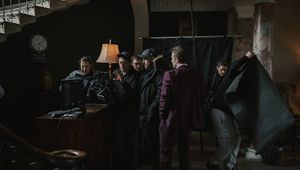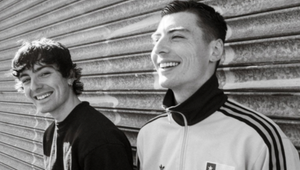
“Just Let Life Happen” Says Banjoman Director About Capturing Real Emotion for Allianz

How do you capture something real in an industry obsessed with polish? For Dermot Malone, the answer was clear the moment he read the brief for Allianz’s latest campaign. Ditch the shoot schedule, strip back the crew, and roll 35mm film like it’s a wildlife documentary.
Working closely with Forsman & Bodenfors, Dermot embedded himself into the lives of real people — including his own family — to uncover the gentle, chaotic, and deeply familiar moments that make up ‘Real Life’.
He speaks to LBB’s Olivia Atkins about patient filmmaking, the power of imperfection, and why the best direction is sometimes no direction at all.
LBB> What was the brief from Forsman & Bodenfors, and how did you interpret it?
Dermot> The brief was to create a brand film to launch Allianz’s new campaign, Real Life. From the moment I saw it – the references, the deck, the written brief – I had a moment of total clarity. I knew instantly that the only way to do this justice was to treat it like a wildlife documentary: to observe, not impose. That meant stepping away from the traditional two-day shoot model and instead spending real time with our subjects. We ended up shooting over eight days, which allowed us to find genuinely authentic, interesting people and give them the space to just be themselves. That soft, observational approach is what led to the moments you see in the film.
LBB> The spot leans heavily into naturalism and imperfection – how did the agency’s concept guide or evolve once you began directing?
Dermot> From the start, the agency team was incredible – totally aligned with the vision and full of trust. Their original brief already leaned into naturalism, and once I proposed stripping things back – minimal crew, minimal interference – they backed it 100%. In fact, they weren’t even present for most of the shoot, which speaks volumes about their confidence in the process. It wasn’t so much that the concept evolved, it was more that everything clicked from day one. There was trust and love from the client in every direction.
LBB> Casting real people rather than actors adds such a rich layer of authenticity – how did you find them, gain their trust, and approach directing them differently than trained talent?
Dermot> It’s completely different from working with actors. One thing I did, which was a bit of a cheat code, was cast people from my own life. So, my grandparents, my wife, my daughter, my parents, cousins… They’re all in the film. That existing trust and intimacy allowed for those small, genuine moments. Beyond that, we didn’t use a traditional casting director. Instead, we had a research team who went out to find interesting families and individuals. We met them multiple times, visited them in their homes, and gradually built trust. Directing them was never about delivering a performance. It was about making them comfortable and letting them live their lives on camera. Sometimes the only direction was “Let’s make dinner,” or “Let’s go to the shops,” and then just letting it unfold naturally.
LBB> Were there any moments where their unfiltered reactions or stories changed the course of a scene?
Dermot> Almost every scene. That’s exactly what we were hoping for – those unpredictable, organic beats. We'd ask things like, “What would you be doing right now?” and follow their rhythm. The dog tearing up the toilet roll, someone shuffling in bed, a kid flipping a ball, spaghetti hitting the floor, none of it was planned, but all of it was golden. Those unfiltered moments are what make the campaign even more real.
LBB> You described shooting the spot like a wildlife documentary – can you talk more about that philosophy and how it influenced the on-set approach?
Dermot> I was inspired by the patience and intimacy of David Attenborough-style documentaries, Planet Earth and Blue Planet. Those crews spend months, even years, waiting for the right moments. That was the mindset here. Some shots in the film last maybe two or three seconds, but we spent an entire day getting them. It was all about creating an environment where people felt relaxed, never rushed, and just letting life happen.
LBB> What kind of preparation and patience did that style require?
Dermot> Preparation was mostly about logistics. Finding the right people, choosing the locations, and having a few loose ideas for what might happen each day: play football, cook a meal, take a bath. But beyond that, it was all about patience. Just being there, ready with the camera, waiting for the magic to occur naturally.
LBB> Shooting on 35mm film feels so integral to the texture and tone of this piece – what led to that choice, and how did the client respond to such an analogue, imperfect medium in a digital-first world?
Dermot> As soon as I read the brief, I knew it had to be shot on 35mm. Not to sound pretentious, but film has this inherent imperfection that mirrors the theme of the piece. It gives each frame a personality and that analogue warmth just feels instantly more human. Of course, the client had some reservations, especially around monitoring and review, but huge credit to head of production Matt D’Arcy and EP Keith Bradley. We devised a system to record off the monitor and keep the client in the loop. In the end, I wouldn’t have done it any other way.
LBB> The spot has a beautifully understated soundtrack – how did you choose the music, and what role did it play in grounding the emotional tone of the piece?
Dermot> The music came from the agency – full credit to them. It was there from the beginning and completely set the tone. It gave the film a sense of understated badass-ery. I love it. It makes the world feel grounded and alive.
LBB> The locations feel incredibly intimate and lived-in – how did you approach location scouting, and what made these particular places feel right for the story you wanted to tell?
Dermot> Every location you see is the actual home of the person in that scene. So we cast the people first, and the locations followed. That was intentional. I didn’t want to dress or modify the spaces at all as that would immediately break the authenticity. The whole goal was for the subjects to feel at home, not on set, and that’s why the spaces feel so lived-in and real.
LBB> The tagline ‘Real Life. Written by You. Underwritten by Allianz’ clearly shaped the creative, how did you translate that into a cohesive directorial vision, especially when working with unpredictable, unscripted moments?
Dermot> The clarity of that line made everything fall into place. I always think the best briefs don’t take long to crack, and this was one of those. 'Real Life' meant no rehearsals, no blocking, no pretence. We had to avoid anything that felt like lifestyle wallpaper or a stock montage. People can spot what’s real and what’s not – audiences are smart. So it became about trusting the process and letting real life happen. And honestly, I loved every minute of it.















